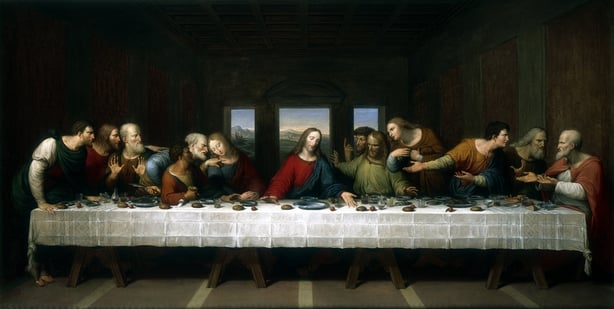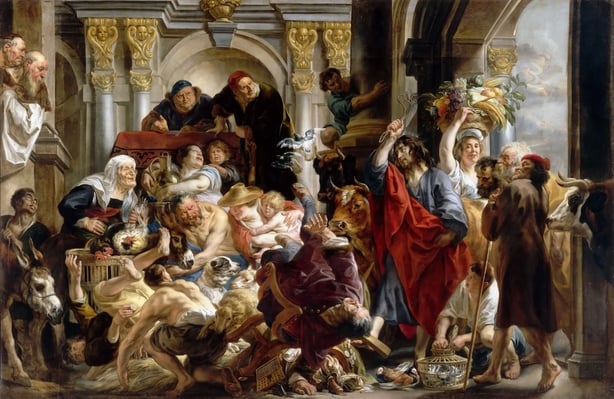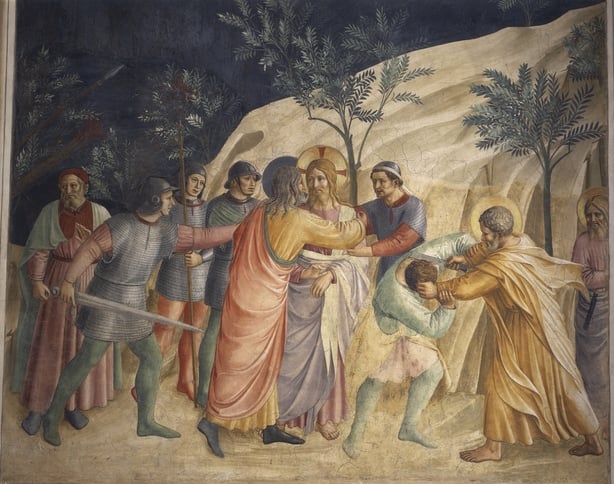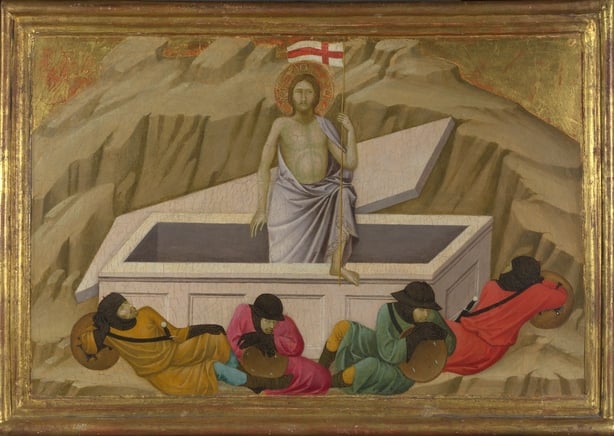How can we sure Jesus existed? Who did he think he was? What were his intentions? A look at what we know about what happened nearly 2,000 years ago
Helen K Bond is Professor of Christian Origins and Director of the Centre for Christian Origins at the School of Divinity at the University of Edinburgh. Here, she discusses some of the many questions people have about Jesus, the events of Holy Week and how we know what we we know.
Q - Can we be sure Jesus existed?
There’s no doubt that Jesus existed. It’s true that the first pagan to mention him is Tacitus in the early second century - who says that Jesus was crucified by Pontius Pilate - but we wouldn’t expect Romans to take much note of a peasant like Jesus until his movement started to make an impact on the empire as a whole. The fact that Paul writes about him within 20 years or so of his death does seem pretty conclusive – even if Paul never met Jesus himself, he knew Jesus’ brother James and people who had been followers of Jesus. In fact, we have much earlier and more reliable evidence for Jesus than we do for Alexander the Great and many other figures from ancient history!
Q - How do we know what we know about the last week of Jesus’ life?
Most of our evidence for Jesus’ last week comes from the New Testament Gospels, written in the last few decades of the first century (Mark was probably the earliest, written around AD 70). Although there are differences on the level of detail, they each give a broadly similar outline of Jesus’ arrival into Jerusalem, his arrest, some kind of a hearing before both Jewish and Roman authorities, and his eventual crucifixion and resurrection.
There’s also a short passage in the first century Jewish historian Josephus (Antiquities of the Jews, 18), which largely corroborates this sequence of events. The passage as a whole seems to have been enhanced by later Christian copyists, but the section on Jesus’ last week seems largely untouched.
Finally, there’s a short passage in rabbinic writings which tells of Jesus’ trial on the charge of sorcery, and a lengthy (and unsuccessful) hunt for witnesses to speak in his defence. Although the passage is unlikely to be historical, it does suggest that when it was written (probably around the third century) it was generally accepted that Jesus was put to death because of controversies with the Jewish religious leaders.

Q - How much can we realistically say about the timeline of a story that took place 2,000 years ago?
The tradition of a holy week comes largely from Mark’s gospel. The evangelist says that Jesus entered Jerusalem on a donkey the Sunday before his death (which gives the traditional date for Palm Sunday). Jesus overturns the tables of the moneychangers in the temple the next day (Monday), and spends the next two days countering opponents and teaching his disciples (Monday/Tuesday).
As the clock ticks, Mark gets more specific: two days before the Passover the Jewish authorities plot against him and enlist Judas (Wednesday); Jesus has one last meal with his disciples (Thursday evening); and is arrested later that night. As Friday dawns, Mark gives a detailed countdown to Jesus’ death: at 6am, he’s brought before Pilate; at 9am, he’s crucified; at noon, darkness covers the earth; at 3pm, he dies and by sundown, he’s is in the tomb.
The author of Mark’s gospel wants to show that Jesus’ shameful death is the will of God. Despite his initial support, Jesus goes from hero to zero within the space of one short week, and the ticking clock emphasizes the inevitability of events. But the tradition of a holy week may well pre-date the gospel. There’s no hard evidence, but it’s easy to imagine the earliest Christians remembering the death of Jesus by focusing on the events of his last few days. Certainly, in 1 Corinthians 11, St Paul connects the Eucharist with Jesus’ last evening. And while we can’t be sure about the exact sequence of events, the broad outline may well go back to the actual life of Jesus.

Q - Why was the presence of a Galilean healer and preacher like Jesus such a threat to the political and religious authorities that they wanted him dead?
To appreciate the threat Jesus posed, you need to understand the religious and political situation in Jerusalem in around 30 AD. The feast of Passover celebrated Jewish liberation from slavery in Egypt and attracted thousands of Jewish pilgrims from all over the Roman Empire. Crammed into the tiny walled city of Jerusalem, or squeezed into the villages round about, people joined in a time of national celebration – renewing old acquaintances, enjoying much welcome leisure-time and sharing hopes for the future.
For Rome, however, the festival was a security nightmare. Pilate, the Roman Governor, usually lived in the city of Caesarea on the coast, but he came to Jerusalem with a body of troops specifically to maintain law and order at festival time. The crowds, the religious fervour and, of course, the highly visible Roman presence itself, all created a tinderbox which needed only the tiniest spark to incite riots and disturbances. Pilate and the High Priest Caiaphas were well aware of this, and both had the same aim: to keep the peace at this highly volatile season, at all costs.
Many things about Jesus would have worried the authorities. He arrived from Galilee with a reputation as a powerful healer and exorcist, riding into the city amidst cheering supporters and excited pilgrims. He preached the Kingdom of God in a world where Caesar was King, and caused a commotion in the Temple itself. What made Jesus particularly dangerous, though, were the crowds who flocked to him wherever he went. In the unpredictable Passover season, crowds could quickly turn dangerous and threaten the precarious stability of the city. It’s no surprise, then, that Jesus was on the radar of both the chief priests and the Romans, and no surprise either to find them working together to remove him as quickly as possible.

Q - Who did Jesus think he was?
It’s really difficult to know who Jesus thought he was. We have to be a little careful in our use of the gospels on this point. All of them were written several decades after the resurrection and reflect later Christian speculation on Jesus’ identity. They present him as the Messiah of Jewish expectation, the unique Son of God, the King of Israel, Saviour of the world, even the divine "Word of God".
In all probability, Jesus’ own view of himself was much less exalted. The Hebrew word "messiah" simply means "anointed one", and although it could be used for a kingly figure who would sweep away Israel’s enemies, it was also commonly used for priests and prophets.
It’s likely that Jesus saw himself as anointed by God for a particular task. He probably saw himself as a prophet, like those of the Old Testament (Isaiah, Jeremiah and so on). He may even have seen himself as God’s last envoy, with a final message to give to the people of Israel before God himself came with power and might. It also seems likely that he had a particularly close relationship to God; several early traditions suggest that he referred to God as father (or "abba" in Aramaic). All of this suggests that he had a strong sense of prophetic calling and an intimate relationship with God.
We need your consent to load this rte-player contentWe use rte-player to manage extra content that can set cookies on your device and collect data about your activity. Please review their details and accept them to load the content.Manage Preferences
From RTÉ Archives, Morgan O'Sullivan asks people in Dun Laoghaire in 1979 about their impression of Jesus Christ and what they consider special about him
At some point in his ministry, Jesus seems to have become convinced that it was the will of God that he should take his message to Jerusalem. Perhaps at first he hoped that he would have the same success that he had enjoyed in Galilee. Certainly the gospels suggest that he was initially greeted with enthusiasm – the story of the "triumphal entry" into Jerusalem has crowds cheering him on his way.
But very soon, things turned sour. Jesus probably realised that he was in danger: Jerusalem had a habit of killing prophets, and his mentor John the Baptist had been put to death only a few years before. His outburst in the temple was a direct challenge to the chief priestly establishment. Perhaps he hoped that God would intervene in some way and save him, but he must have reckoned with the probability that his days were numbered. What drove him on was not so much a death wish as a total obedience to God’s will, wherever it led.
Q - What were Jesus' intentions? Did he intend to start a new religion?
Jesus didn’t intend to start a new religion and he lived and died an observant Jew. His movement was concerned with the renewal of the Jewish faith. He called people to repent of their sins and to live their lives in anticipation of God’s kingly rule. The 12 disciples represent the 12 tribes of Israel, renewed and reinvigorated in a new age. And Jesus rarely takes his message to non-Jews in the gospels, although there are hints here and there that in the future golden age all people will be welcome.
Jesus wasn’t unique in any of this – other Jews of his day preached national renewal, and others healed and attracted a following. John the Baptist shows several similarities to Jesus, and the Jewish historian Josephus mentions several other prophetic figures who emerged a decade or so later on. Like Jesus, all of these men ran up against the political or religious authorities and ended up dead.
Without Judas, Jesus wouldn’t have gone to the cross, and human salvation would have looked very different.
What distinguished Jesus was the Christian belief in the resurrection. It was this one event - the utter conviction that Jesus had been raised by God and exalted to heavenly glory - that enabled his followers to rise above the horrific events of the crucifixion and to continue their mission. By now what they preached wasn’t just the words of Jesus, but the mind-blowing event of the resurrection. It was belief in this, according to followers like St Paul, which offered a new possibility of salvation for all people.
Q - Judas is history's most famous traitor. Is there any basis for seeing him in any other way?
I’ve always felt a little sorry for Judas. Peter denies his master and is quickly forgiven, but Judas’ crime is considered too terrible for forgiveness. The tradition preserved by Matthew has him killing himself, while the tradition preserved in Acts has God striking him down. And yet, without Judas, Jesus wouldn’t have gone to the cross, and human salvation would have looked very different.
It’s almost impossible to work out Judas’ motives for betraying Jesus. Was it for money? Had he become disillusioned? Had the chief priests got to him in some way? The Countdown to Calvary documentary airs the idea that Judas wanted to bring things to a head, to engineer a face-to-face meeting between Jesus and the priestly authorities. In this case, a more neutral translation of the Greek verb used for Judas’ action, "paradidomi", such as ‘hand over,’ might be appropriate.
But my guess is that this whole interpretation attempts to exonerate Judas too much. The Greek word paradidomi has a range of meanings, but "betray" is certainly one of them. Moreover, the whole of the Christian tradition, starting from very early on, remembers Judas as a traitor. This was deeply embarrassing, and opponents of the new faith tried to score points by jeering at a leader who was betrayed by one of his closest followers. If Judas’ act had been anything other than a betrayal, it seems likely that the earliest Christians would have gone out of their way to say so.

Q - How reliable are the Gospels?
The people who wrote the Gospels clearly believed that what they were writing was true, that God had intervened uniquely in human affairs by sending his only son to redeem all people through his self-sacrificial death. But this does not necessarily mean that every single detail of their accounts is historically accurate.
Our earliest Gospel (Mark) was probably written around 40 years after the events it describes, and the other three were based on this earlier version. The later evangelists are quite happy to alter the Markan version when it suits them; what was most important was getting the theology right, rather than historical accuracy. This might seem strange to us in a society that prizes facts and figures, but ancient biographies were generally more concerned with presenting the bigger picture rather than researching details (which in any case were hard to verify).
There had also been a number of important changes between the time of Jesus and the writing of the Gospels – the Jerusalem Temple had been destroyed by the Romans, the message was now spreading throughout the Roman Empire, and most converts to the new faith were Roman rather than Jewish. Each of these meant that the message had to be retold and adapted to new social situations.
Q - Did the Gospel writers succumb to the temptation to spin the story and promote their new religious movement at the expense of the older Jewish one?
Yes, quite definitely. A good example of this is the strained relations between Christians and Jews by the end of the first century. By now, Christian preaching in the synagogues had resulted in hostility and resentment, and in many places a split between the two faiths. Not surprisingly perhaps, this led to Christian antagonism towards Jews and a greater openness towards Romans, who were far more likely to join the new movement.
But one huge difficulty for earliest Christian preachers was the fact that Jesus had been crucified, executed by the Roman governor as a threat to the state. Not surprisingly, this was a huge problem for potential Roman converts – who would want to follow such a man? Christian preachers seem to have quickly come up with a strategy: they had to admit that Jesus was crucified, but they argued that Pilate had been reluctant to send him to the cross, and that those most responsible were the Jewish authorities.
When the gospels were written, Christians were very much in the minority
Already in Mark’s Gospel, the Jewish trial takes precedence, with a council meeting, the calling of witnesses, and a formal death sentence. The Roman trial is overshadowed by the choice of the people (at the instigation of the chief priests) of Barabbas and their demand for Jesus’ crucifixion. The Roman Governor, Pilate, seems nothing more than a bit-part player in all of this (a role which seems very unlike what we know of the harsh and abrasive Pilate of history). Matthew goes even further, adding the detail that Pilate washed his hands of the whole affair, and the infamous cry of the Jewish people ‘His blood be on us and on our children.’ Neither of these details is likely to be historical, but they were of enormous use in early Christian preaching to Romans.
Q - Amos Oz refers colourfully and provocatively to the Gospel writers' depiction of "the Jews" as "the Chernobyl moment" - a ‘cold-blooded’ act of anti-semitism. Has he got a point? How does one defend them against that charge?
Read in a modern, post-Holocaust world, there’s no doubt that certain aspects of the Gospels’ depiction of Jews are deeply troubling. But I don’t entirely agree with Oz on this point. Anti-semitism is a 19th century term which implies hatred of Jews on the grounds of race or ethnicity. What Oz overlooks is the fact that the gospel writers come from a Jewish context themselves. It’s precisely their Jewish heritage which makes the divorce from the parent religion and all its accompanying antagonism so hard to swallow.
The picture is a complex one. Matthew’s cry of "all the people" ("his blood be on us . . ." etc) has had a disastrous effect on Jewish history throughout the centuries, leading directly to the charge that Jews were ‘Christ-killers.’ Yet Matthew’s Gospel is also deeply Jewish – it’s important to this evangelist to show that the life of Jesus was in accordance with the Scriptures and to present Jesus as a new Moses.
As so often in cases of divorce, it is those that the evangelists were once closest to that they can later despise the most. Reflecting on the historical circumstances in which the Gospels were written, particularly the history of antagonism and rejection by the Jewish synagogue, helps to put some of this into perspective.
It’s worth reflecting on another point too. When the gospels were written, Christians were very much in the minority. They were a new religious group desperately fighting for survival and forging their identity in the face of much larger and more significant Jewish communities. However, the works of minority groups sound rather different when they become the majority, and when their texts become the dominant ones. I wouldn’t want to minimise the level of anti-Jewish hostility in the Gospels, nor play down the devastating effect that certain passages have had on Jews throughout the centuries, but I don’t think that fuelling anti-semitism was in any way an intention of the evangelists.

Q - Do any of the discoveries or theories in Countdown to Calvary threaten Christian faith?
I’ve taught courses on the historical Jesus for over 20 years now and I’m always surprised by how threatening some people can find it. I’ve come to the conclusion that many Christians don’t really believe that Jesus was "fully human" (as the creeds would later express it). Some are offended at any suggestion that Jesus wasn’t unique, or that he had "normal" human aspirations, disappointments or failings (let alone a sex-life!). They imagine that Jesus knew that he was divine all along, that he floated through Galilee in a bubble of pious obedience, safe in the knowledge that his imminent death would save humankind. For these people, there is no distinction between the theologically-charged stories of the gospels and the real human being who inspired them, and I imagine that anyone holding such views will find much to trouble them in Countdown to Calvary.
But I hope that most viewers will be more open-minded and allow themselves at least to reflect on the human Jesus at the heart of the Christian story, along with his hopes, dreams and frustrations. Attempting to understand him in his first century context is not at all to diminish him – quite the opposite, it’s to take the incarnation seriously and to ask what we can know about this extraordinary human individual. In the end, I believe that Christian faith is only threatened when people stop asking questions.
The views expressed here are those of the author and do not represent or reflect the views of RTÉ

